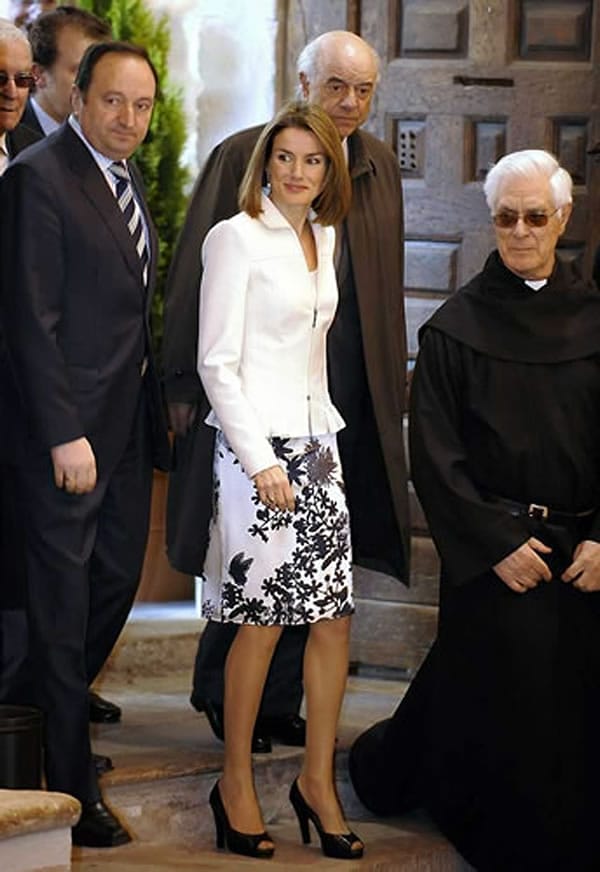It was not the first time that the community of La Rioja, specifically the monastery of Yuso of San Millán de la Cogolla, was visited by the princess. In this occasion the presence of a member of the royal household was not only a matter meant to enhance the event inside the walls of the monastery. The princess seemed to have enjoyed in the company of her old colleagues while treating more deeply communication issues.
This activity has been taking place since its creation in 1998 by the San Millán Foundation through the units established to fulfill its objectives. Organized by the Foundaciones del Español Urgente (Fundéu BBVA) and San Millán de la Cogolla, the seminar checked for three days the linguistic level of the journalists working in Spanish.
The concern about the growing vulgarization of the language in the world of journalism and the academic formation of the professionals of the mass media were some of the questions discussed.
Other matters of discussion among the lexicographers, academicians and the attending professors were the future of the digital journalism and the concerns around the levels of linguistic sensationalism of the press of the heart.
Aside from the princess Letizia who presided the affair, other personalities graced the inauguration with their presence, namely, the president of the autonomous region of La Rioja, Pedro Sanz, the presdient of the Agency Efe, Álex Grijelmo; an officer representing BBVA, Gray Angel; the director of the Real Spanish Academy and president of the Fundéu BBVA, Víctor Garcia de la Concha, and the journalist Manuel Vicent, who read the inaugural address.


Monastery of Yuso. The Call of History
Many things appear in the news about San Millán, or concretely about the monastery of Yuso (literally of the underneath). There is no need to be meticulous about details such as dates, persons and institutions that leave a mark on a journey that joins the past with the present to be able to build a better future.
The members of the UNESCO, gathered in Naples on December 4, 1997 to proclaim both monasteries and their surroundings as world heritage, had already in mind that it was not all about some symbolic buildings, not even about emphasizing the place of the thousand-year-old codex of a language that was spoken among the townspeople. But rather they were also interested in the continuity of life, in this case, religious life, well documented in these places since 1500 years ago.
It all began, as thus the things of the great and proximate God, with the hermitic aspirations of a simple shepherd of Vergegio (Berceo), Millán or Emiliano, in the caves of Suso and the hills of Distercios. Men and women came to join him and communities emerged that gave way to popular legends, monastic aspirations and royal yearnings (kings of Nájera-Pamplona), a second monastery in the Valley (down under or Yuso). The great Benedictine Order, without which it is not possible to understand Europe, established itself in both monasteries and introduced huge progress in all levels (cultural, religious, social…). But dark times for the religion in Spain came. Monasteries, libraries, centers of spirituality and many important places ended up in disinterested hands of others in the 19th century or simply abandoned to the mercy of time.
The monasteries of Suso and Yuso were almost completely abandoned for over forty years. Some of their treasures were lost, others ended up in the museums, private houses and libraries inside and outside of Spain or were saved miraculously. In 1878 a religious congregation, the Recollects of St. Augustine, whose charism, at the beginning, was not associated with similar huge structures neither with cultural research, took possession of the monastery of Yuso, the only one of the two that at that time was habitable. From there they took care as shepherds of the faithful of San Millán. The years went by. In 1908 an important general chapter was held there. In 1948 a new religious province within the Order of Augustinian Recollects chose the place as their general headquarters from which they would send missionaries to the lands of America.
The minimum upkeep of the house proved to be hard. In the years 70, the friars and a group of friends from La Rioja founded the association Friends of San Millán. It was then that the Millenium of the Language was being celebrated with the royal family of Spain making their first visit to the place. With the creation of the autonomous region of La Rioja efforts were done to strengthen ties with the worlds of politics and of culture. Two wings of the monastery were surrendered to the La Rioja government for their restructuring. Not long after a hotel started to operate in one of them. It took time before the other wing could function.


In the year 2007 the CILENGUA (Center for Language Studies) was finally established. Cradle of the Spanish Language
In the year 2007 the CILENGUA (Center for Language Studies) was finally established, although cultural activities were being done during the previous years. The year 1997 was a breakthrough for the two monasteries of San Millan. It was then that they were conferred with the laurel of being a world heritage.
In the following year, the San Millan Foundation was created with the involvement of the royal family, the politicians and the community of the Augustinian Recollects. Many businesses, institutions, individuals joined as either members or collaborators of the Foundation. The two monasteries gradually underwent renovation both in their structure of stones, their furniture, paintings and books. The cultural world, the political circle and the community of Augustinian Recollects kept working together to bring to completion and perfection this project undertaken not many years ago.
The community of Augustinian Recollects, aside from extending pastoral care to the faithful of the Valley (Berceo, San Millán, Estollo, San Andrés and El Rio), also carries out a commendable work in the study and cataloguing of its bibliographical resources together with the specialists, attends and organizes the visits of all types of people who come to the monastery of Yuso and is in continuous contact with the regional authorities, above all through the person of the prior of the monastery, who is the secretary of the San Millán Foundation.
The religious community, aside from doing its part in raising funds together with other institutions and agencies, tried to renovate the old Benedictine and Augustinian novitiate house and converted it into a welcoming house of spirituality for persons and groups yearning for retreats, for formation, and for spiritual rest. Significant gatherings have taken place here like the first assembly of bishops of the Order of Augustinian Recollects towards the end of 2008, as well as workshops on formation, renewal and spirituality of the same Order and of other religious groups. All commended the environment, silence and quality of the facilities.
There are still many things to be done for the entire campus of the San Millan monasteries: introduction of development programs to the people of the place, total renovation of the monasteries, improvement of the marketing and communication areas, holding of religious and cultural events, promotion of tourism…Without doubt each year brings in new achievements and ideas for the integral development of this Valley of San Millán de la Cogolla. That is what we hear from the thousands of visitors who come here every year for whatever reason.


